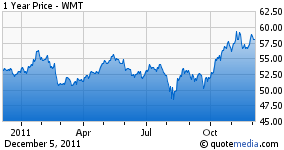By Mark Bern, CPA CFA
 Wal-Mart (NYSE:WMT) is the world’s largest retailer. Everything about this company is measured in staggering numbers, except one: Same-store sales. But after nine consecutive months of declines, finally, in July, August and September same-store sales were positive. Same-store sales are sales in stores open more than a year compared year-over-year. Unfortunately, we can’t tell just how good the news really is because management declines to reveal the number.
Wal-Mart (NYSE:WMT) is the world’s largest retailer. Everything about this company is measured in staggering numbers, except one: Same-store sales. But after nine consecutive months of declines, finally, in July, August and September same-store sales were positive. Same-store sales are sales in stores open more than a year compared year-over-year. Unfortunately, we can’t tell just how good the news really is because management declines to reveal the number.
The company seems to have learned a lesson because it is returning 10,000 items to its shelves that were removed previously in order to concentrate sales with fewer suppliers with the expectation of further reducing costs. Customers spoke with their wallets and shopped for their preferred brands elsewhere. The results were unexpected by management, but I have to give them credit for recognizing the mistake and taking corrective action.
Management also plans to reduce prices by $2 billion per year to widen the cost advantage for customers over competitors even further. This is likely to reduce gross margins by about 50 basis points, but management also has plans to decrease sales, general and administrative (SG&A) expenses by 100 basis points over the next five years.
Another priority of management is profitability from international operations. WMT will apply the principles that have worked in its North American stores more closely to foreign operations - using more locally produced goods to drive down costs where possible.
The growth engine seems to have cooled down some over the past decade and that has led to a contraction of the Price/Earnings (P/E) ratio from the mid-30s to the low teens. The P/E currently stands at 12.3 while the price (as of the close on Friday, December 2, 2011) lingers at $58.09.
The price a decade ago (the week of December 3, 2001) was $55.34 and